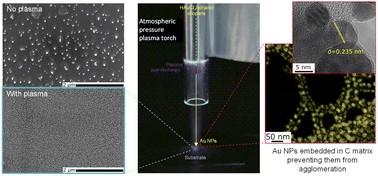Gold nanoparticles synthesis and immobilization by atmospheric pressure DBD plasma torch method†
Abstract
Herein, we report the impact of plasma on gold nanoparticles synthesis. We used an atmospheric plasma torch fed with an aerosolized tetrachloroauric(III) acid trihydrate (HAuCl4·3H2O) solution. The investigation showed that using pure ethanol as a solvent for the gold precursor enabled a better dispersion compared to a water-containing solution. We demonstrated here that the deposition parameters are easy to control, presenting the influence of solvent concentration and deposition time. The advantage of our method is that no capping agent was used. We assume that plasma creates a carbon-based matrix around the gold nanoparticles preventing them to agglomerate. The XPS results revealed the impact of using plasma. Metallic gold was detected in the plasma-treated sample, whereas the no-plasma sample revealed only Au(I) and Au(III) contributions originating from the HAuCl4 precursor. Detailed HRTEM, EDS mapping, and SAED analyses led to more insights into the structure.



 Please wait while we load your content...
Please wait while we load your content...